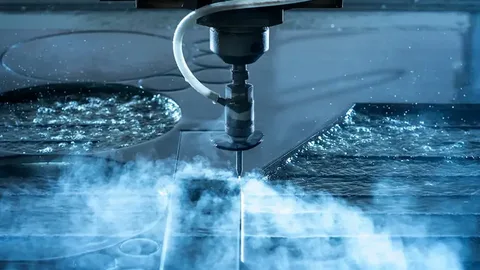Waterjet cutting is a highly precise method for cutting thick materials without generating heat. Unlike traditional cutting techniques such as plasma or laser cutting, waterjet cutting is a cold process, meaning it does not produce heat-affected zones (HAZ). This prevents material warping and ensures the structural integrity of the material remains intact, making it ideal for applications requiring high precision.
Additionally, waterjet cutting offers an exceptional level of accuracy, often achieving tolerances as tight as ±0.005 inches. This precision allows manufacturers to create complex and intricate shapes without the risk of thermal damage. The ability to cut materials without heat-induced changes makes waterjet cutting a preferred choice for industries such as aerospace, automotive, and heavy manufacturing.
Versatility in Material Cutting
One of the biggest advantages of waterjet cutting is its versatility. This technology can cut through virtually any material, including metals, ceramics, stone, glass, composites, and plastics. It is particularly beneficial for cutting thick materials, as it can handle materials up to 12 inches thick with ease, depending on the type of material being processed.
Unlike other cutting methods that struggle with extremely hard or brittle materials, waterjet cutting can smoothly slice through dense and layered materials without causing microfractures or chipping. This makes it an excellent option for industries that require precision cutting of materials with varying thicknesses and densities, such as construction and heavy machinery manufacturing.
Environmentally Friendly and Minimal Waste
Waterjet cutting is an environmentally friendly process compared to other cutting technologies. It does not produce harmful fumes, dust, or toxic gases, making it a safer option for both workers and the environment. The process uses only water and abrasive particles, reducing the need for hazardous chemicals or coolants that can contribute to pollution.
Moreover, waterjet cutting minimizes material waste due to its precise cutting capabilities. The narrow kerf width of the waterjet stream ensures that minimal material is removed, allowing for better material utilization and cost savings. Industries focused on sustainability and reducing material waste, such as green manufacturing and eco-friendly construction, benefit significantly from waterjet cutting technology.
No Tool Wear and Low Maintenance
Unlike conventional cutting methods that rely on mechanical components, waterjet cutting does not involve direct contact between the tool and the material. This results in minimal tool wear, extending the lifespan of the cutting equipment and reducing maintenance costs. The absence of heat-related wear and tear further enhances the durability of waterjet cutting machines.
Additionally, waterjet systems require relatively low maintenance compared to other cutting technologies. While the nozzle and abrasive delivery system may need periodic replacements, the overall maintenance is far less demanding than that of laser or plasma cutters. This reliability and reduced downtime make waterjet cutting a cost-effective solution for manufacturers handling thick materials.
Enhanced Safety and Ease of Operation
Safety is a critical factor in industrial cutting applications, and waterjet cutting excels in this area. Because it operates without heat, there is no risk of burns, fire hazards, or toxic fumes that are common with laser or plasma cutting. This significantly improves workplace safety and reduces the need for extensive protective equipment.
Furthermore, modern waterjet cutting systems are designed with user-friendly interfaces, allowing operators to program complex cutting patterns with ease. Computer Numerical Control (CNC) integration enhances precision and repeatability, ensuring consistent results even for high-volume production. The combination of safety and ease of use makes waterjet cutting an attractive option for industries requiring efficient and reliable cutting of thick materials.
Conclusion
Waterjet cutting is a superior technology for processing thick materials due to its precision, versatility, environmental benefits, durability, and safety. By eliminating heat distortion, reducing material waste, and ensuring consistent accuracy, this cutting method stands out as an essential tool for industries dealing with thick and complex materials. As advancements in waterjet technology continue, its adoption will likely expand across various sectors, further reinforcing its advantages over traditional cutting methods.




